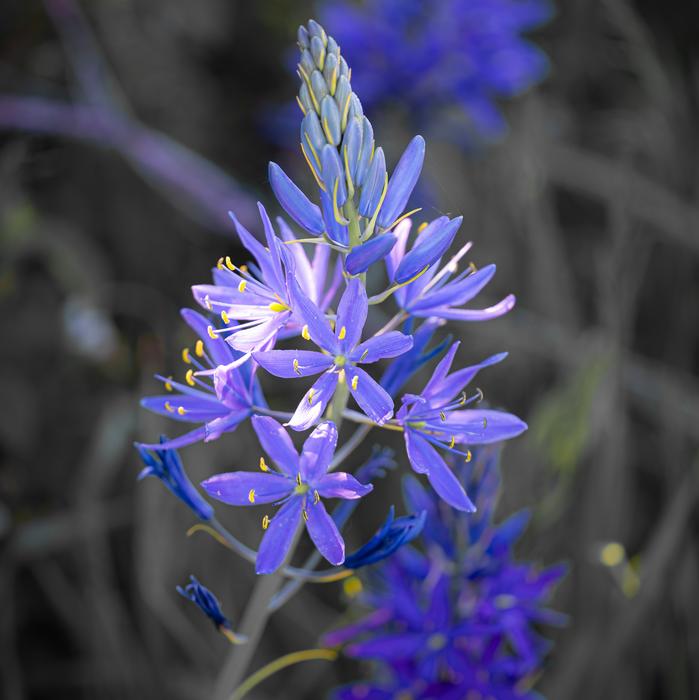An Oregon State University study found evidence that Indigenous groups in the Pacific Northwest were intentionally harvesting edible camas bulbs at optimal stages of the plant’s maturation as far back as 3,500 years ago.

Credit: Jon Boeckenstedt, Oregon State University.
An Oregon State University study found evidence that Indigenous groups in the Pacific Northwest were intentionally harvesting edible camas bulbs at optimal stages of the plant’s maturation as far back as 3,500 years ago.
The findings contribute to the growing body of research around Traditional Ecological Knowledge and practices, demonstrating the care and specificity with which Indigenous groups have been stewarding and cultivating natural resources for millennia.
Camas is an ecological and cultural keystone, meaning it is a species that many other organisms depend on and that features prominently within many cultural practices.
“If you think about salmon as being a charismatic species that people are very familiar with, camas is kind of the plant equivalent,” said Molly Carney, an assistant professor of anthropology in OSU’s College of Liberal Arts and lead author on the study. “It is one of those species that really holds up greater ecosystems, a fundamental species which everything is related to.”
An eye-catching blue flower that grows widely throughout the Pacific Northwest, camas is referred to in Indigenous calendars across the region, with the plant’s growth stages used as a sort of seasonal benchmark. It is often included in traditional First Food ceremonies, in which tribal communities mark the coming of spring with the first salmon run or the first edible roots after a long winter, Carney said.
Camas bulbs must be baked for two to three days to render them edible. Once soft, the bulbs taste a bit like sweet potato, Carney said. Traditional baking was done in underground ovens using heated rocks.
The archaeological record Carney examined included the remains of these large pit ovens. After cooking the bulbs, Indigenous peoples had many ways to process camas and were able to store it for many months at a time. (Even Lewis and Clark’s diaries mention eating camas they were given by Nez Perce tribal members.)
In the recent study, published in The Holocene, Carney looked at camas bulbs from the Willamette Valley in Oregon dating back 8,000 years to determine when in their life cycle they were harvested. Similar to how tree rings help to estimate how old a tree is, counting the interior leaf scales of a camas bulb lets you estimate its age. Camas grows to harvestable size in three to five years, depending on soil conditions.
Camas baking ovens from 4,400 years ago have been recorded at a Long Tom River archaeological site near Veneta, Ore., but for several thousand years, the bulbs appeared to have been harvested somewhat indiscriminately. Carney found that around 3,500 years ago, the bulbs started being harvested more selectively at the point when the plants were four or five years old and had reached sexual maturity.
This timing in the Late Holocene period lines up with broader climatic shifts in the region, the researchers noted, coming around the same time as low-magnitude fires became more commonplace in the landscape. Carney also studied lake-core evidence from the floor of Beaver Lake, collected by Central Washington University researcher Megan Walsh, that gives credence to the theory that controlled burns were used intentionally to create optimal conditions for camas and other plants starting 3,000 to 4,000 years ago.
Based on her research, Carney says it’s clear that Native communities at the time were not selectively harvesting for the biggest possible bulbs, but rather stewarding camas to be sustainable over time.
“They were trying to maintain the age structure of these camas populations within a pretty narrow window,” she said. “When I had the opportunity to harvest alongside tribal communities, as they harvest, they replant the smaller bulbs as they go. They’re really sowing for future harvest, and that’s what I think was happening here.”
The shift from haphazard harvesting to selective stewardship among tribal communities appears to have occurred at approximately the same time throughout the Pacific Northwest, Carney said. And for the practice to be successful, it would have required community-wide agreement and cooperation to leave immature camas bulbs in the ground until the optimal harvest point, as well as to conduct the type of cultural burning necessary to maintain healthy growing spaces, the researchers note.
“We have these records showing that people were taking active roles in creating landscapes that fit their needs, and that they’ve been doing so for 3,500 years at least, based on these two proxies of camas and fire,” Carney said. “That provides a powerful claim for restoring these practices.”
Co-author on the study was Thomas Connolly from the Museum of Natural and Cultural History at the University of Oregon. The project was approved by the Confederated Tribes of Grand Ronde Historic Preservation Office.
Journal
The Holocene
Method of Research
Observational study
Subject of Research
Not applicable
Article Title
Scales of plant stewardship in the precontact Pacific Northwest, USA
Article Publication Date
6-May-2024
COI Statement
The author(s) disclosed receipt of the following financial support for the research, authorship, and/or publication of this article: Par- tial financial support was provided by the Oregon Archaeological Society Roy F. Jones Memorial Scholarship and the University of Arkansas.



